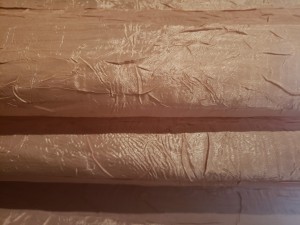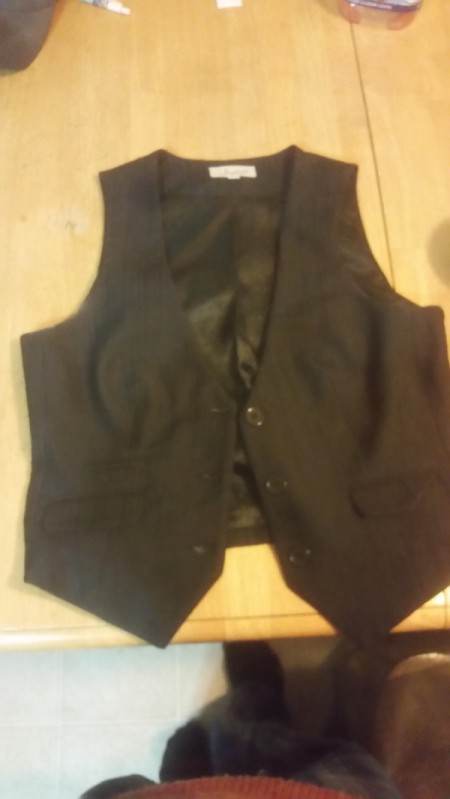 Can I dye gold polyester sheers white?
Can I dye gold polyester sheers white?
I have doubts that this will be successful as very often item will never be a true white as polyester is difficult to work with.
Also, the seams may be cotton blend and may turn out to remain a darker shade.
Also, the original 'color' of the curtain material may not have been true white before it was dyed as some curtain material may be a 'natural' color (could have been light beige) and that could prevent it from turning out snow white.
I think, if you try this, you should be prepared to maybe dye your curtains another color just in case they are not true white.
Also, if these are not new curtains, the extra 'movement' that is required may weaken the fabric and cause tears.
There is no way to turn any colored fabric white without first removing the color, in your case gold.
Avoid using chlorine-based bleaches, such as sodium hypochlorite (which is the active ingredient in most household bleach). They cause permanent damage to polyester in the form of a dull yellowish stain that cannot be removed.
Not all dye colors can be removed. Some dyes are easy to remove, but others cannot be removed, no matter what you do. Unless you know exactly what dye was used on your material, the only way to find out whether it can be removed is to try it. Therefore, take a not big piece of your fabric and try removing the color.
How to remove dye from fabric:
Combine the dye-stripping product and the required amount of water (as designated on the packaging) in a stainless steel pot.
You can also try "White discharge disperse dye polyester".
For White Discharge the printing paste is prepared as follows:
200 parts Safolin, 70 parts Water, 650 parts Loust bean gum (10%) or Meyprogum (8%), 30 parts Citric acid or (1 - 2 parts Tartaric acid), 50 parts Thiodiethylene Glycol. 1000 parts textilechemrose.blogspot.com/
Your fabric should lose its gold color and turn white or at least light. If it doesn't turn completely white, then you need to turn it white.
Natural dyes work at the cellular level with natural fibers - natural is defined as originating from plant or animal sources. Polyester fibers are not made up of cells, but consist of long chains of molecules derived from petroleum as an industrial byproduct. Although liquid polyester can be colored during the fiber-formation process, modern chemical dyes have been developed to color finished polyester textiles. To dye polyester, you need chemical dyes that react with the synthetic fibers. The class of chemical dyes used for polyester fabrics is called dispersion dyes. You can dye polyester to any other color at home using dispersion dyes in a hot-water dye bath, but not white, as there is no white dispersion dyes.
There are several options for turning polyester to white (try them using the piece of your fabric):
1. Using an opaque pigment.
However, unlike dyes, pigments do not have any ability to stick to the surface. In order to make a pigment stick, you have to mix it with something that will act as a glue. Titanium dioxide is a good white pigment, but, like any pigment, without a binder to glue it on to the fabric, it will just fall off. If you mix it with an acrylic fabric medium, then it can stick; dry heat treatment may be necessary to make the effects of the acrylic binder permanent.
2. Using fabric paint.
The mixture of a pigment with a binder is called paint. You shouldn't use just any paint on fabric, because many of them dry to be stiff, hard, and scratchy. For painting fabric, you need to buy special fabric paint. Many fabric paints are just as transparent as dyes, so you have to look specifically for an opaque fabric paint. Some fabric paints will bind to natural fibers, but not to synthetic fibers such as polyester, so be careful to choose an opaque fabric paint whose manufacturer specifies that it will work on synthetic fibers. Jacquard Products makes a line of opaque fabric paints called Neopaque that is supposed to work on both natural and synthetic fibers.
Here are the questions asked by community members. Read on to see the answers provided by the ThriftyFun community.
I have a dark blue/black vest that I want to bleach so I can turn it brown. It is 78% polyester, 19% rayon, and 3% spandex.
Any opinions out there if this would work at all or just ruin the vest?
I think you have figured out the best solution to repair the vest your have ruined.
I am the mother of the bride. I recently bought a light teal colored dress. It's thin material and is double layered; the under layer is a solid material the top is a lacey type; 90% nylon, 10% spandex, and a 100% polyester.
Can I dye it a dark blue and if so how?RIT carries a line of polyester dye. They're available at most drugstores and Amazon
I would snip a piece from the hem or seam and try that before I dyed the whole dress.
Before dyeing a garment, I always ask myself this question - what will I do if it is ruined? Or is a totally different color than I wanted? If you feel that it will be alright with "okay" to either question then maybe you can try some of the methods suggested.
Polyester is very unpredictable and does usually dye well even with dye "made" for poly. I am assuming this is a one piece dress which means the dye will have to be for polyester, nylon and spandex. Many dyes require heat at some point and that may be a problem with these materials.
Have you thought about taking your dress to an upscale dry cleaners and ask their opinion and price - IF - they will consider doing it. I do not believe they will and if they do, they will not give you any kind of guarantee.
i assume you cannot return the dress but maybe you can try one method and if it does not turn out to suit you - maybe a new dark blue dress is in order?
I want to dye some lavender colored curtains burgundy colored. The problem is they are 100% polyester. Has anyone tried this?
By Brenda
Polyester will not take Rit dye. There may be other dyes available through specialty shops online but Rit works best on natural fibers like cotton or silk.
Don't waste your money, it doesn't work and you end up with something you won't like at all. I tried again recently and boy were the results ugly...argh! Dye has really gone up in cost in my area so really felt doubly foolish thinking it might work "this time". It won't.
We've been disappointed even by polyester/cotton blends and dyes. Even the blends don't take the dyes well, so I wouldn't risk it. I think you'd just lose your money. However, I've seen lots of really nice burgundy curtains in thrift shops lately that look great and don't cost a lot. Good luck!
I have a black vest that I want to dye a dark blue. I know that I'll have to bleach it (or do something to get rid of the color) first. However, the research I've done has been really contradictory on what I should do for the fabric I have. The vest is 69% polyester, 29% rayon, and 2% spandex.
(The lining is 100% polyester.) Would bleach ruin this fabric? Again, I don't need to completely get this white, I just have to make it light enough so I can dye it a dark blue. Thank you in advance to any solutions!You will ruin the vest. You can dye it darker, not lighter.
Bleach will ruin almost any clothing with even a small amount of polyester so please - put the bleach away.
Rit has a color remover but states polyester may not have good results.
There does not seem to be a really,really safe way to dye or redye polyester material. Please check out some of these links before attempting anything like this with your garment unless you plan to be satisfied if it finishes badly. Also, doing anything with polyester requires very hot water and washing machine cannot be used.
The washer does not get hot enough for the poly dye. The dye only becomes activated with boiling temperature. It sometimes looks good after the washer, but usually the dye rubs off on legs arms and furniture.
The washer does not get hot enough for the poly dye. The dye only becomes activated with boiling temperature. It sometimes looks good after the washer, but usually the dye rubs off on legs arms and furniture. "Idye natural works great in the washer, the poly does not."
www.thespruce.com/